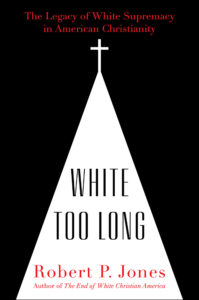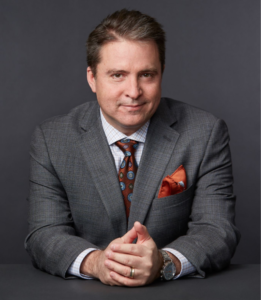Racist Too Long: Measuring White Christianity an Interview with Robert P. Jones

Ed. Note: This is an excerpt of a longer interview that will appear in the September/October issue of the Humanist magazine. Read the full interview here.
The election of Donald J. Trump as president of the United States brought to the forefront a politicized form of Christianity that combines white evangelicalism, white nationalism, and the prosperity gospel. However, as CEO and founder of the Public Religion Research Institute (PRRI) Robert P. Jones notes in his new book, White Too Long: The Legacy of White Supremacy in American Christianity, these beliefs have been present in America since the beginning. Drawing upon PRRI’s comprehensive public opinion surveys and historical analysis, along with his personal experience growing up Southern Baptist in Mississippi, Jones delivers a groundbreaking study of Christianity in the US. In unpacking this history, Jones offers insights that can help humanists and other nonreligious individuals understand this complex history and the role they can play in moving the conversation on race forward.
Becky Garrison: Your new book is called White Too Long: The Legacy of White Supremacy in American Christianity. The subtitle suggests it’s the white supremacy in American Christianity that needs to go. But the main title is a bit more radical. What exactly does it mean?
Robert P. Jones: The book title was inspired by James Baldwin, from a New York Times op-ed he wrote in early 1969 following the murders of Martin Luther King Jr. and Bobby Kennedy. Here’s the full quote:
I will flatly say that the bulk of this country’s white population impresses me, and has so impressed me for a very long time, as being beyond any conceivable hope of moral rehabilitation. They have been white, if I may so put it, too long; they have been married to the lie of white supremacy too long; the effect on their personalities, their lives, their grasp of reality, has been as devastating as the lava which so memorably immobilized the citizens of Pompeii. They are unable to conceive that their version of reality, which they want me to accept, is an insult to my history and a parody of theirs and an intolerable violation of myself.
So, yes, the problem is that American Christianity needs to excise itself from white supremacy—the practices and teachings that reveal a commitment to the idea that white lives are more valuable than Black lives—but that can only happen if Christians do the rigorous work of disentangling which parts of their religion are about being white and which parts are about being Christian. Given our history, this is no small task.
Garrison: PRRI’s 2017 report “America’s Changing Religious Identity” and your first book The End of White Christian America (2016) point to the decline if not the demise of white Christianity. What do you see as the value of now examining the legacy of white supremacy in American Christianity?

Robert P. Jones
Jones: In the first book, I looked at data showing that from 2008 to 2014 the country had gone from being 54 percent to 47 percent white and Christian. That number today is 42 percent, so it’s even dropped another five percentage points. Indeed, we are now at a very different place in the country compared to when the vast majority of white Americans identified as Christian. Having said all that, white Christians remain a significant factor in American politics, especially given the fact that 81 percent of white evangelicals voted for Donald Trump in the 2016 election. Also, Christianity served as the cultural force that really shaped so many of our institutions and our policies. The legacy of that movement continues to be very much with us today.
Garrison: Why do you say that white supremacy became embedded in the DNA of American Christianity?
Jones: Looking back at American history, white Christian churches were in fact biracial churches, in that both whites and Blacks worshipped together. However, the reality was that slave owners were bringing enslaved people to church with them. Whites would sit in the front and enslaved people would sit in the back or in specially constructed balconies. The sermons, prayers, and liturgies were all by definition and design constructed to be compatible with a worldview in which it was okay for whites to own Black Americans.
Garrison: As you note in your book, even those Christians who didn’t speak out in favor of slavery still supported the enslavement of Black people.
Jones: I think it was a combination of outright justification and silence that was the one-two punch of white Christianity. When you go back to the abolitionist debates in the 1800s, those white Christians who were defending the practice of slavery actually felt they had the Bible on their side. Many more white Christians were simply silent. Even after slavery ended, the institution of Jim Crow laws, which were widely legitimized and defended by white Christian leaders, reinforced this very clearly constructed society that valued and protected the lives of white people at the expense of Black people.
Garrison: What is the “racism index” you refer to in the book?
Jones: One of the tricky things about measuring racial attitudes in public opinion surveys is that if you rely on one or two questions, the answers people give may not be broadly representative of their views. One of the ways I try to protect against that potential skew is by using a broad set of fifteen different questions on racial attitudes. These questions focus on issues of structural racism and touch on Confederate symbols; racial inequality and African-American economic mobility; racial inequality and the treatment of African Americans in the criminal justice system; and perceptions of race, racism, and racial discrimination. I then combine the responses to all fifteen questions into a single composite measure.
Garrison: For those who place the blame of Christian white supremacy on Southern evangelicals, how are white mainline Protestants and white Catholics also complicit in this regard?
Jones: Basically, what we ended up finding was a very clear pattern whereby all three of the major white Christian subgroups—evangelical, mainline, and Catholic—cluster fairly closely together and score fairly high on the racism index. Southern evangelicals have higher scores than other white Christians, but it’s really only a matter of degree not a kind. Evangelicals were more extreme in their views, but all three groups were fairly consistent in holding racist views.
Garrison: How did unaffiliated white Americans score on the racism index?
Jones: Conversely, white religiously unaffiliated Americans scored fairly low on this index. If you start looking at the differences between white Christians of any kind and white religiously unaffiliated folks in America, you see enormous differences. In question after question, religiously unaffiliated white Americans hold less racist views than white Christians do. Some may say that’s because the former tend to be younger and they’re more likely to live in urban areas, have a college degree, and less likely to be Republican. But even when I put in controls for factors like partisanship, education level, and geography, these patterns still stand up. What that tells you is that, among whites, there is something about Christian identity that is actually shaping these attitudes. You don’t see this pattern among whites who are religiously unaffiliated.
Those who are unaffiliated are more likely to sympathize and identify with the key issues raised by groups such as Black Lives Matter. For example, white Christians of all kinds are about twice as likely as religiously unaffiliated whites to say that the killing of African-American men by police are isolated incidences, and that they have nothing to do with each other. They don’t see the connection of these killings as part of a pattern of how police treat African Americans. The data suggests their kind of Christianity and their racial identity hinder them from seeing structural injustice. It’s notable that white Catholics and white mainline Protestants largely share in this worldview despite having different histories and geographic locations than white evangelicals.
Check out the September/October issue of the Humanist magazine for the entire interview.
